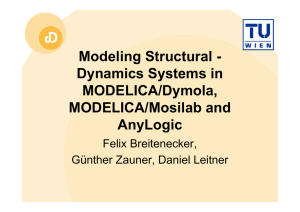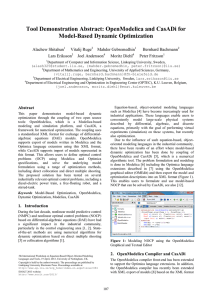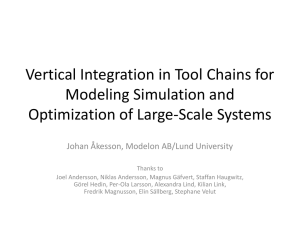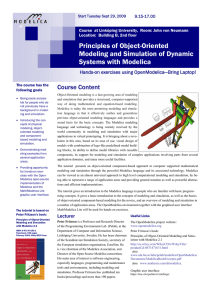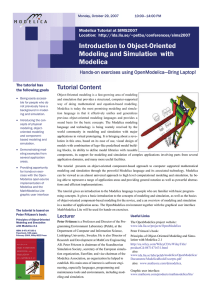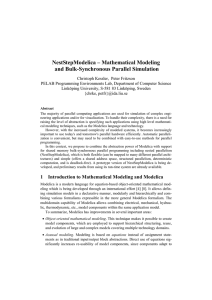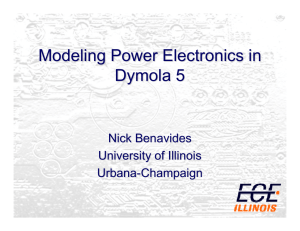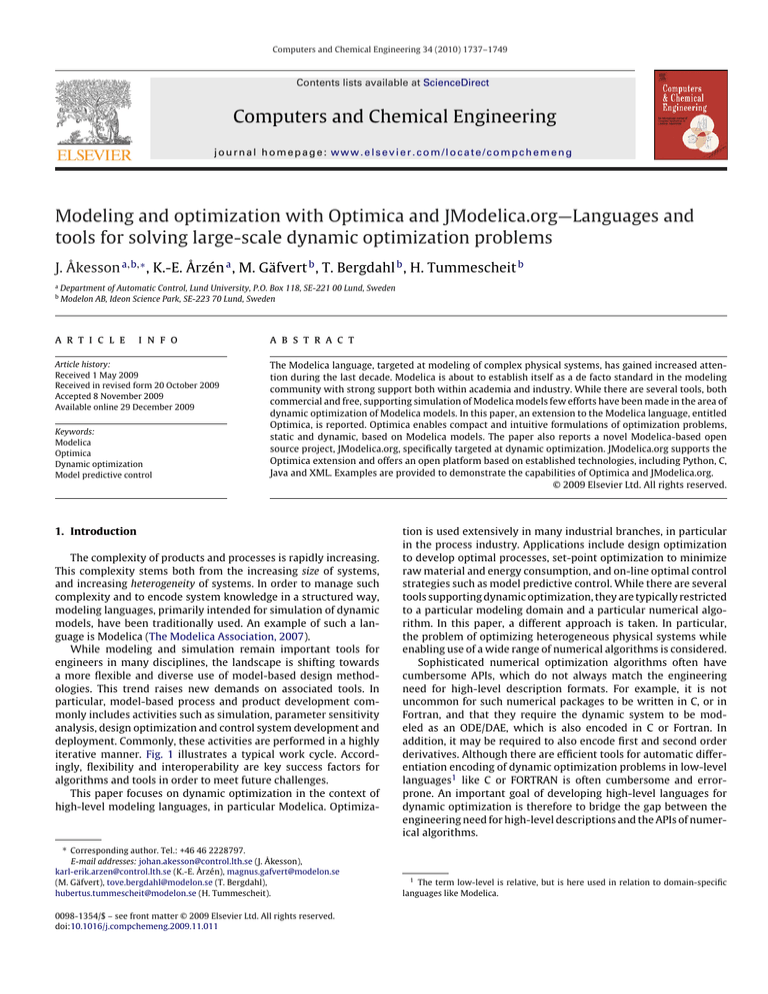
Computers and Chemical Engineering 34 (2010) 1737–1749
Contents lists available at ScienceDirect
Computers and Chemical Engineering
journal homepage: www.elsevier.com/locate/compchemeng
Modeling and optimization with Optimica and JModelica.org—Languages and
tools for solving large-scale dynamic optimization problems
J. Åkesson a,b,∗ , K.-E. Årzén a , M. Gäfvert b , T. Bergdahl b , H. Tummescheit b
a
b
Department of Automatic Control, Lund University, P.O. Box 118, SE-221 00 Lund, Sweden
Modelon AB, Ideon Science Park, SE-223 70 Lund, Sweden
a r t i c l e
i n f o
Article history:
Received 1 May 2009
Received in revised form 20 October 2009
Accepted 8 November 2009
Available online 29 December 2009
Keywords:
Modelica
Optimica
Dynamic optimization
Model predictive control
a b s t r a c t
The Modelica language, targeted at modeling of complex physical systems, has gained increased attention during the last decade. Modelica is about to establish itself as a de facto standard in the modeling
community with strong support both within academia and industry. While there are several tools, both
commercial and free, supporting simulation of Modelica models few efforts have been made in the area of
dynamic optimization of Modelica models. In this paper, an extension to the Modelica language, entitled
Optimica, is reported. Optimica enables compact and intuitive formulations of optimization problems,
static and dynamic, based on Modelica models. The paper also reports a novel Modelica-based open
source project, JModelica.org, specifically targeted at dynamic optimization. JModelica.org supports the
Optimica extension and offers an open platform based on established technologies, including Python, C,
Java and XML. Examples are provided to demonstrate the capabilities of Optimica and JModelica.org.
© 2009 Elsevier Ltd. All rights reserved.
1. Introduction
The complexity of products and processes is rapidly increasing.
This complexity stems both from the increasing size of systems,
and increasing heterogeneity of systems. In order to manage such
complexity and to encode system knowledge in a structured way,
modeling languages, primarily intended for simulation of dynamic
models, have been traditionally used. An example of such a language is Modelica (The Modelica Association, 2007).
While modeling and simulation remain important tools for
engineers in many disciplines, the landscape is shifting towards
a more flexible and diverse use of model-based design methodologies. This trend raises new demands on associated tools. In
particular, model-based process and product development commonly includes activities such as simulation, parameter sensitivity
analysis, design optimization and control system development and
deployment. Commonly, these activities are performed in a highly
iterative manner. Fig. 1 illustrates a typical work cycle. Accordingly, flexibility and interoperability are key success factors for
algorithms and tools in order to meet future challenges.
This paper focuses on dynamic optimization in the context of
high-level modeling languages, in particular Modelica. Optimiza-
∗ Corresponding author. Tel.: +46 46 2228797.
E-mail addresses: johan.akesson@control.lth.se (J. Åkesson),
karl-erik.arzen@control.lth.se (K.-E. Årzén), magnus.gafvert@modelon.se
(M. Gäfvert), tove.bergdahl@modelon.se (T. Bergdahl),
hubertus.tummescheit@modelon.se (H. Tummescheit).
0098-1354/$ – see front matter © 2009 Elsevier Ltd. All rights reserved.
doi:10.1016/j.compchemeng.2009.11.011
tion is used extensively in many industrial branches, in particular
in the process industry. Applications include design optimization
to develop optimal processes, set-point optimization to minimize
raw material and energy consumption, and on-line optimal control
strategies such as model predictive control. While there are several
tools supporting dynamic optimization, they are typically restricted
to a particular modeling domain and a particular numerical algorithm. In this paper, a different approach is taken. In particular,
the problem of optimizing heterogeneous physical systems while
enabling use of a wide range of numerical algorithms is considered.
Sophisticated numerical optimization algorithms often have
cumbersome APIs, which do not always match the engineering
need for high-level description formats. For example, it is not
uncommon for such numerical packages to be written in C, or in
Fortran, and that they require the dynamic system to be modeled as an ODE/DAE, which is also encoded in C or Fortran. In
addition, it may be required to also encode first and second order
derivatives. Although there are efficient tools for automatic differentiation encoding of dynamic optimization problems in low-level
languages1 like C or FORTRAN is often cumbersome and errorprone. An important goal of developing high-level languages for
dynamic optimization is therefore to bridge the gap between the
engineering need for high-level descriptions and the APIs of numerical algorithms.
1
The term low-level is relative, but is here used in relation to domain-specific
languages like Modelica.
1738
J. Åkesson et al. / Computers and Chemical Engineering 34 (2010) 1737–1749
Fig. 1. A typical work cycle for formulation and solution of dynamic optimization
problems.
This paper presents an extension of the Modelica language
(The Modelica Association, 2007), entitled Optimica, dedicated to
high-level formulation of dynamic optimization problems based
on Modelica models. Optimica consists of a few but powerful new
language constructs that enable the user to express optimization
problems using high-level descriptions on par with Modelica. Using
the Optimica extension, optimization interval, cost function, constraints and information related to the numerical algorithm used
to solve the problem can be specified. A key feature of Optimica
is that the formulation of the optimization problem is done independently of the numerical algorithm used to solve the problem.
Rather, the algorithm and associated control parameters are specified using light weight language constructs that make it easy to
evaluate the applicability of several different algorithms.
In order to demonstrate the feasibility and effectiveness of
the proposed Optimica extension, a Modelica-based open source
platform called JModelica.org (Modelon AB, 2009) is under development. The objective of the JModelica.org platform is to create a
flexible and extensible Modelica environment focused on optimization. The software consists of several parts; compiler front-ends
to transform Modelica and Optimica code into a canonical representation, compiler back-ends to generate efficient model code
(currently C and XML), implementations of dynamic optimization algorithms. In addition, the compilers and algorithms have
been interfaced with Python in order to offer a convenient scripting and prototyping environment. The main objective of the
project is to create an industrially viable Modelica environment
for optimization, yet offering rich opportunities for research. In
particular, JModelica.org forms a vehicle for communicating industrially relevant applications into the academic community and for
propagating state of the art numerical algorithms developed in the
academic community into industrial use. JModelica.org can also be
used for experimental language design where Modelica is extended
with new functionality, or as a comprehensive environment for
teaching. For more information, see the JModelica.org home page
(Modelon AB, 2009).
The paper is outlined as follows. In Section 2, backgrounds on
Modelica, dynamic optimization, and optimization tools is given.
In Section 3, the Optimica extension is presented. Section 4 gives
an overview of the JModelica.org open source project, and examples are given in Section 5. The paper ends with a summary in
Section 6.
2. Background
2.1. Modelica
Modelica is the result of an effort to create a unified modeling
language for complex heterogeneous physical systems. The effort
started in the mid nineties with the objective of gathering practitioners from several application fields, including thermo-fluid
systems, robotics, electronics, mechanics and avionics. In addition,
researchers specializing in computer science were part of the group
that published the first version of the Modelica language specification in 1997. The language is continuously maintained and
developed by the non-profit organization The Modelica Association
(2007)—since the start in 1997 there have been about 60 design
meetings where the language has been discussed and improved.
The latest version of the specification, Modelica 3.0, was published
in September 2007.
The Modelica language builds on principles of earlier languages,
notably Omola (Mattsson & Andersson, 1992). Also, the bond graph
formalism (Karnopp & Rosenberg, 1968), influenced the design. One
of the main targets of Modelica is to enable modeling of different
physical domains in one unified language. This approach differs
from some other modeling frameworks such as SPICE (Nagel &
Pederson, 1973) and VHDL-AMS (IEEE, 1997) which are specialized
on electrical circuits, gPROMS (Process Systems Enterprise, 2007)
specialized in chemical processes, and ADAMS (MSC Software,
2007) specialized in simulation of mechanical systems. While this
heterogeneous modeling strategy enables a high degree of flexibility, it should also be noted that Modelica lacks some specialized
features, for example intrinsic PDE support.
Modelica shares several properties with other modern modeling languages, including gPROMS and VHDL-AMS. Modelica is an
object-oriented language, supporting fundamental concepts such
as packages, classes, inheritance, and components. These abstractions enable structuring and reuse of complex models. Modelica
is based on acausal equations, rather than assignment statements.
This property has far-reaching consequences in terms of ease of
use, since it enables the user to input equations, both differential and algebraic, in a natural text-book style. In particular, this
features eliminates the need to solve for the derivatives. In order
to enable component-based modeling, Modelica offers a mechanism to explicitly model acausal physical interfaces: connectors. A
connector models the physical quantities involved in the interface
by means of through and across variables, e.g., flow and pressure.
When a component with connectors of the same type is connected, the signal directions need not be determined by the user,
but are rather given by the topology of the component network.
This methodology is fundamentally different from that of blockbased modeling used in e.g., Simulink, see Åström, Elmqvist, and
Mattsson (1998) for a discussion. Modelica also supports joint textual and graphical modeling, mixed continuous discrete (hybrid
behavior), user defined functions, and interfacing with external C
or Fortran code. For a comprehensive overview of Modelica, see
Fritzson (2004).
Typically, Modelica code is organized into reusable model
libraries. Commonly, domain expert knowledge is encoded in the
form of Modelica libraries, which are then used by application
engineers to construct model instances corresponding to a particular process or plant. The users of Modelica can then be roughly
categorized into two groups: library developers and application
developers. Library developers typically work with encoding of the
laws of nature in the form of differential algebraic equations and
structuring of the code. Application engineers on the other hand,
typically use predefined components and connect them together
in a graphical model editor. There are numerous Modelica libraries
available, both commercially and freely available, ranging from
thermodynamics and power plants to automotive and space applications. There is also a freely available standard library for Modelica
from The Modelica Association (2007).
While the Modelica language provides a convenient modeling
environment, Modelica code is typically not immediately suitable
for integration with numerical algorithms. A Modelica tool therefore needs to perform several transformation steps in order to
produce model code which in turn can be interfaced with an algorithm for simulation or optimization. The procedure is illustrated
ID
173049
Title
ModelingandoptimizationwithOptimicaandJModelica.org—Languagesandtoolsforsolvinglarge-scale
dynamicoptimizationproblems
http://fulltext.study/article/173049
http://FullText.Study
Pages
13


